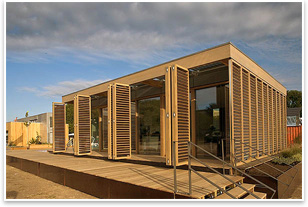 Fourth DOE Solar Decathlon Set for October in Fourth DOE Solar Decathlon Set for October in
Washington, D.C.
Tens of thousands of visitors expected to the National Mall to view new designs
By Gideon Fink Shapiro
Summary: The Solar Decathlon scheduled for this October in Washington, D.C., is only the fourth such event of its kind, but already the new generation of student designers is questioning the dominant trends in design.
1. First Place, 2007, Technische Universität Darmstadt. Photo by Jim Tetro, Solar Decathlon, 2007.
2. Sunrise at the Solar Decathlon Village. Photo by Cécile Warner, NREL, 2005
Sponsored by the U.S. Department of Energy, the Solar Decathlon competition challenges participating teams to design an 800-square-foot solar-powered house whose performance is measured by 10 criteria ranging from engineering to market viability and—new for 2009—net metering. The first three Decathlons, staged in 2002, 2005, and 2007, established sustainable home design as an area of broad public interest. Tens of thousands of visitors to the National Mall lined up for tours of the many intriguing designs.
But perhaps inevitably, the meaning of the official judging results has been the subject of ongoing debate. One common criticism is that the designs are too expensive to be relevant to the mainstream home market. The equally common rejoinder is that mass production would lower the costs. But to what extent are the Decathlon homes actually conceived as prototypes for sustainable living? Other functions have helped guide their development: The homes are educational research projects for the students and faculty who create them, they are prestige symbols for the universities that sponsor them, and they are advertisements for the companies that supply their parts.
The winning house in 2007, designed by the Technische Universität Darmstadt, Germany, was encircled with photovoltaic louvers that ingeniously allowed for the modulation of natural light and solar energy production throughout the day. Like the 2005 winner by the University of Colorado, it won crucial points by generating surplus electricity, part of which was used to power an electric car. If hi-tech solar is the reigning paradigm, many of this year's teams have grown more competitive in this regard, while others have taken another approach entirely. Critics say these winners' superior PV capacity has skewed the competition toward more expensive, technologically driven designs, the costs of which can exceed $1 million.
The Rice University team, for example, decided to focus less on victory in the Decathlon and more on creating a house that could transform ordinary communities in Houston. Conceived in collaboration with the Row House Community Development Corporation and the Rice Building Workshop, the "Ze-Row House" could become a model for single-family housing in the low- and moderate-income Third Ward. "We don't plan on necessarily winning this competition," said David Dewane, the lead student architect on the project, "We scaled down our array to generate the load this house really needs. Our priority was to make this one of the most affordable Decathlon houses ever, and this is a critique of what we've seen in the past."
The University of Minnesota team, participating for the first time this year, has developed a design that "fits with existing ideas of what a house looks like," according to Ann Johnson, the faculty project manager. This vernacular approach could arguably improve the design's performance in the market viability category, and by extension its chances for making an impact beyond the Decathlon. Johnson says the university may use or adapt the team's "Icon House" for a new sustainable community it is planning in UMore Park, a 5,000-acre tract of undeveloped land.
 The Cornell University team, which won second place in 2005, is also embracing a decidedly vernacular look. Its formal vocabulary, however, is agricultural rather than residential in origin. The house's circular volumes of corrugated Cor-Ten steel are inspired by the grain silos that dot the landscape of upstate New York. Team leader Chris Werner, who will graduate from the master of architecture program this December, was a first-year student when he participated in the 2007 project. "This time we wanted to do something riskier," he said. As notable as the home's rustic forms are its functioning landscape and water recycling system. Separate tanks for potable water, gray water, and dirty water are concealed beneath the undulating ground plane, while an exposed water trough filters gray water through hydroponics. Cornell sold its past two Decathlon houses to private owners, and hopes to do the same this year to help cover costs. The Cornell University team, which won second place in 2005, is also embracing a decidedly vernacular look. Its formal vocabulary, however, is agricultural rather than residential in origin. The house's circular volumes of corrugated Cor-Ten steel are inspired by the grain silos that dot the landscape of upstate New York. Team leader Chris Werner, who will graduate from the master of architecture program this December, was a first-year student when he participated in the 2007 project. "This time we wanted to do something riskier," he said. As notable as the home's rustic forms are its functioning landscape and water recycling system. Separate tanks for potable water, gray water, and dirty water are concealed beneath the undulating ground plane, while an exposed water trough filters gray water through hydroponics. Cornell sold its past two Decathlon houses to private owners, and hopes to do the same this year to help cover costs.
As for the sitting winner, TU Darmstadt, their 2009 team appears to have started fresh. The new house will have very little in common with its 2007 predecessor, according to project manager Johanna Henrich, save perhaps a sophisticated system of built-in furnishings. PV panels will be fixed rather than movable, and the design includes an elevated loft level. With two elevations and the roof to be covered in PV panels, the house will again convert large amounts of solar energy. Giving this technical muscle a practical value, the team says the house could function as an add-on or "gamete," supplying energy and extra space to an existing primary dwelling.
By mid-April, most if not all of the 20 teams were well into the construction process. Students from various schools and disciplines—from architecture to engineering to construction management—are collaborating daily to solve practical problems. Not surprisingly, many teams report that raising private funds to supplement the $100,000 DOE grant has been especially challenging this year.
What will be this year's most sensational design? One guess is as good as another, but if Spain's Universidad Politécnica de Madrid team is able to realize its radical pivoting roof concept, make sure to get there early to beat the crowds. |



